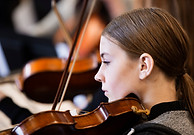
ELEMENTARY EDUCATION
A STRONG FOUNDATION
The principles of Waldorf Education evolve from an understanding of human development that addresses the needs of the growing child. Waldorf schools offer a developmentally appropriate, experiential, and academically rigorous approach to education. They integrate the arts in all academic disciplines for children from preschool through twelfth grade to enhance and enrich learning.
Music, dance and theater, writing, literature, legends and myths are not simply subjects to be read about and tested. They are experienced. Through these experiences, Waldorf students cultivate their intellectual, emotional, physical and spiritual capacities to be individuals certain of their paths and to be of service to the world.
Potomac Crescent Waldorf School offers small classes, an engaging environment, and an individualized approach to teaching that emphasizes whole child development.

LOVE OF LEARNING
The Waldorf curriculum is based on the developmental stages of childhood. Each grade's coursework is brought in a way to reach each child where they are, academically, emotionally and physically.
Teachers use each child's strengths to develop his or her weaknesses allowing for the development of a well-rounded, confident and creative child eager to take on new experiences and knowledge.

DEPTH OF KNOWLEDGE
The Waldorf curriculum allows for in-depth learning, focusing on quality over quantity. Students' understanding of each subject area deepens each year as they circle back to topics to which they were introduced in previous years. The work is challenging without being overwhelming because teachers meet each student where they are.
Each day begins with a 2-hour main lesson that centers on one subject for blocks of three or four weeks. Intensive, uninterrupted study of one subject allows students to explore an area in depth from many angles.
ENRICHING EXPERIENCES




MUSIC
Music fills our school throughout the day. Students often start and end their day by singing. Each child also learns to play the flute and, in the fourth grade, they learn the violin, viola or cello.
WORLD LANGUAGES
Spanish is taught twice a week. The first and second grade children might recite together a poem that is being memorized, sing a simple folk song, play finger or circle games, and practice rhythmical counting. There might be a story period in which the teacher presents a dramatized narration of a short fable. In the second grade, the teacher begins to ask for individual responses and recitations, making the children gradually aware of the social function of language. By the end of third grade, some classes are ready to begin writing a few phrases and words with which they are familiar. Fourth grade marks an important transition toward the written language and grammar is introduced in a more conscious way. In addition, the students study geography and elements of the history of the countries whose language they are studying.
ART
Drawing, painting, building and beeswax modeling are integrated with academic study. Students produce artistic articulations of their lessons and create their own textbooks as a way to develop a deeper understanding of the subject matter.
MOVEMENT
Balance, dexterity and coordination are developed in the Games & Movement class. Gross motor skills, cooperation, confidence, social skills and fun are fostered through our curriculum.
HANDWORK
Handwork skills are taught as a way to develop and enhance several skills: fine motor skills, social awareness, inner balance, alertness, flexibility, and mathematical reasoning. Children start with knitting in first grade and progress to crocheting.

CONNECTION WITH NATURE
At PCWS, children of all ages spend abundant time outdoors every day. We believe in teaching a reverence for nature and a respect for our place in the natural world.
Our grades students take nature walks, participate in multi-day field trips to a biodynamic farm, and go camping to explore classroom subjects.
The curriculum intertwines this outdoor experience into the academic instruction, providing a hands-on, practical understanding of the coursework.

AGE GUIDELINES
Enrolled children should be the recommended age prior to June 1 before the school year.
Grade 1: 6 years old
Grade 2: 7 years old
Grade 3: 8 years old
Grade 4: 9 years old
Grade 5: 10 years old
